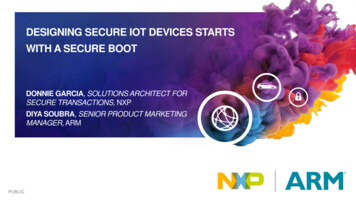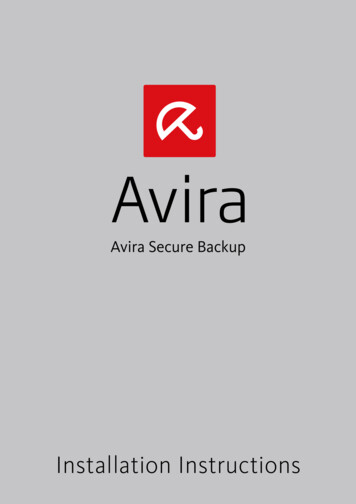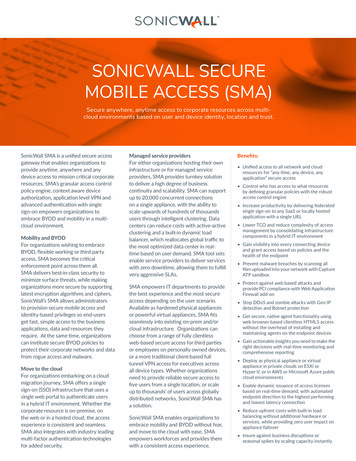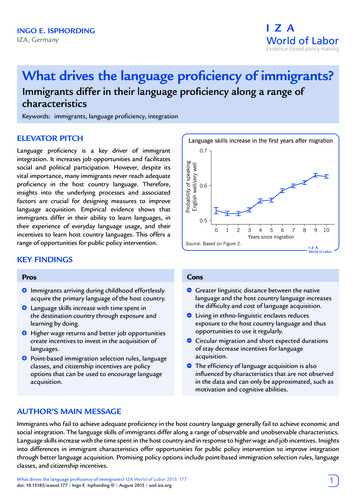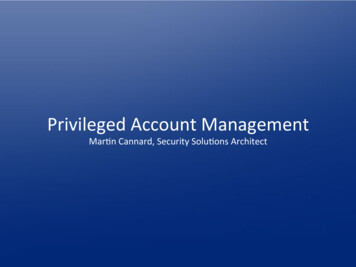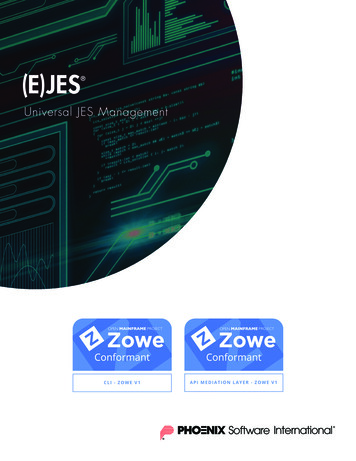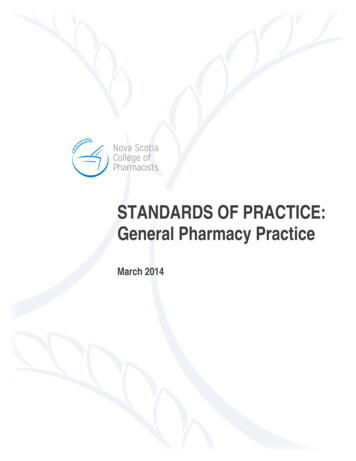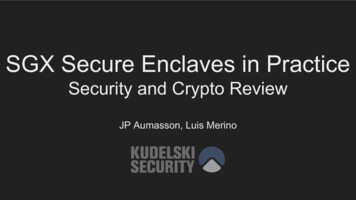
Transcription
SGX Secure Enclaves in PracticeSecurity and Crypto ReviewJP Aumasson, Luis Merino
This talk First SGX review from real hardware and SDK Revealing undocumented parts of SGX Tool and application releases
PropsVictor Costan (MIT)Shay Gueron (Intel)Simon Johnson (Intel)Samuel Neves (Uni Coimbra)Joanna Rutkowska (Invisible Things Lab)Arrigo TriulziDan Zimmerman (Intel)Kudelski Security for supporting this research
Agenda.theoryWhat's SGX, how secure is it?.practice Developing for SGX on Windows and Linux.theoryCryptography schemes and implementations.practice Our projects: reencryption, metadata extraction
What's SGX, how secure is it?New instruction set in Skylake Intel CPUs since autumn 2015
SGX as a reverse sandboxProtects enclaves of code/data from Operating System, or hypervisor BIOS, firmware, drivers System Management Mode (SMM) aka ring -2 Software “between BIOS and OS” Intel Management Engine (ME) aka ring -3 “CPU in the CPU” By extension, any remote attack
Simplified workflow1.2.3.4.5.Write enclave program (no secrets)Get it attested (signed, bound to a CPU)Provision secrets, from a remote clientRun enclave program in the CPUGet the result, and a proof that it's theresult of the intended computation
Example: make reverse engineer impossible1. Enclave generates a key paira. Seals the private keyb. Shares the public key with the authenticated client2. Client sends code encrypted with the enclave's public key3. CPU decrypts the code and executes it
A trusted computing enablerOr secure computing on someone else's computerNot a new idea, key concepts from the 1980sHardware-enforced security requires: Trusted computing baseHardware secretsRemote attestationSealed storageMemory encryption
Trusted computing base CPU’s package boundary: IC, ucode, registers, cache Software components used for attestation (mainly QE)You have to trust Intelanyway if you use anIntel CPU :-)Caveats: You need a trusted dev environment for creating enclaves No secure human I/O: enclave may compute the right result,but the system may show the wrong one on the screen
Hardware secretsTwo 128-bit keys fused at production: Root provisioning key Root seal key (not known to Intel)Derived keys depend on the seal key,so Intel can't know themImage: Intel
Remote attestationProof that an enclave runs a given software, inside a given CPU,with a given security level, for a given ISVSGX mostly useless withoutImage: Intel
Sealed storageEnclaves’ data/code is not secretSecrets are provisioned later, and can be encrypted to be storedout of the enclave through the sealing mechanism: Encrypted blob Stored outside the enclave Only decryptable by the enclave Different keys generated for debug- and production-mode Backward compatibility with newer security version numbers Replay protection, possible time-based policies
Security limitationsCache-timing attacks Programs should be constant-time, cache-safe(SGX won't transform insecure software into secure software)Physical attacks Need physical access, may destroy the chip(such as laser fault injection attacks)Microcode malicious patching Needs special knowledge, persistence difficult
Vulnerability researchSGX is complex, unlikely to be bug-freeMost SGX is black-box, with a large part implemented in ucode :-/ Complex instructions like EINIT, EGETKEY: partiallydocumented, but all ucode; black-box testing/fuzzing? Platform software: Drivers, critical Intel enclaves, etc. SDK: Debug-mode libs available for SGX’ libc and cryptoVulnerabilities can be disclosed at https://security-center.intel.com/
CPU bugsFrom Intel’s 6th Generation family specs update
Bugs in dependenciesExample: SGX’ aesm service.exe uses OpenSSL“ASN.1 part of OpenSSL 1.0.1m 19 Mar 2015”Is CVE-2016-2108 exploitable?
Can SGX be patched?Yes for most of it, including trusted enclaves & microcodeThe memory encryption crypto cannot be patched (hardware)
Developing for SGX
Setup Purchase an SGX-enabled Skylake CPU Enable SGX in the BIOS (if supported) Windows: Install MS Visual Studio Professional 2012 (30-days trial) Install Intel Platform Software and SDK Linux: download and build Platform Software and SDK
HTTPS download of the SDK? Yes but noSame issue with the PSW download
Expired SDK installer certObserved on April 7th, 2016,reported to Intel (now fixed)
Platform Software (PSW)Required to run SGX enclaves, contains: Drivers, service, DLLs Intel privileged enclaves: le.signed.dll: Launch policy enforcement qe.signed.dll: EPID, remote attestation pse.signed.dll: Provisioning serviceAll PEs have ASLR and DEP enabledPEs signed, FORCE INTEGRITY not set
SDKRequired to develop SGX enclaves and applications under VisualStudio 2012 Professional (not free, license needed). SGX libs: Intel-custom libc and crypto lib, each coming in twoversions, debug and release Tools: sgx edger8r to generate glue code sgx sign to sign enclaves with our dev key Example code, not fully reliable
Debugging and disassemblyVisual Studio debugger for debug-mode enclavesRelease-mode enclaves undebuggable, like one big instructionSGX decoded by the popular disassemblers (IDA, r2, etc.)
Developing an enclave applicationAn SGX-based applications is partitioned in two parts: Untrusted: Starts the enclave, interacts with external parties Trusted: Executes trusted code using secrets They can call each other ("ecalls" and "ocalls")Challenges: Minimize the enclave's code, to reduce attack surface Validate untrusted inputs (the OS can’t be trusted)
Dev constraints Syscalls & some CPU instructions are not allowedEnclaves are statically linked (all code must be measured)ring3 only, no kernel modeCan't use the real thing easily Debug mode is not secure Release mode needs an Intel approved developer key(human interaction and NDA required)
Launching enclaves Developers need to be SGX licensees OCSP signer certificate status check (cacheable) Launch Enclave checks attributes and provides a token signedwith the launch key (derives from HW secrets)Major change ahead:Intel will enable custom Launch Enclaves in future CPUs, asrecent documents indicate, to enable custom launch policies
Remote attestationWe want to: Remotely verify the enclave integrity Establish a secure channel client–enclaveIn practice: Handshake to get a proof from the enclave ECDHVerify proof yourself: enclave hash, signature, version, !debugVerify proof against an Intel web serviceIf trusted, provision secrets :)
So, how to handle secrets? Don’t embed them in the codeEstablish trust before provisioning themUse a secure channel terminated in the enclaveSeal them at restDesign the interface to ensure they won't leak
At last! Linux SDK and PSWReleased on June 25thSDK and PSW source code, LE/PE/QE b.com/01org/linux-sgx-driver
Linux SDK & PSW source code 170 kLoCs of C( )BSD License ( limited patent license)Trusted libc derived from OpenBSD's (and some NetBSD)Deps: dlmalloc, Protocol Buffers, STLPort, OpenSSL, etc.Builds shared libraries and CLI tools
Prebuilt built-1.5.80.27216.tarsha256sum on June 7aef02f1c99821d127bPrebuilt enclaves (LE, QE, PVE) with symbols
Crypto in SGXImage: Intel
SGX crypto zoo RSA-3072 PKCS 1.5 SHA-256, for enclaves signaturesECDSA over p256, SHA-256, for launch enclave policy checksECDH and ECDSA (p256, SHA-256), for remote key exchangeAES-128 in CTR, GCM, CMAC at various places: GCM forsealing, CMAC for key derivation, etc. 128-bit security, except for RSA-3072 ( 112-bit)Memory encryption engine (hw), cf. Gueron’s RWC’16 talk: New universal hash-based MAC, provably secure AES-CTR with custom counter block
Built-in SGX crypto lib: “somewhat limited”Libraries sgx tcrypto.lib and sgx tcrypto opt.libAES (GCM, CTR), AES-CMAC, SHA-256, ECDH, ECDSA Secure, standard algorithms, 128-bit security CTR supports weak parameters (e.g. 1-bit counter)
What crypto lib?Code from Intel’s proprietary IPP 8.2 “gold” (2014)Only binaries available (debug-mode libs include symbols)
SGX crypto lib on LinuxSimilar IPP code too, but comes with source code In sdk/tlibcrypto, external/crypto px, etc. SGX public keys in psw/ae/data/constants/linuxClean and safe code compared to some other crypto libs
SDK's AES implementation (Windows)“To protect against software-based side channel attacks, thecrypto implementation of AES-GCM utilizes AES-NI, which isimmune to software-based side channel attacks.“(SDK documentation) AES-NI used for the rounds (AESENC, AESDEC) Not for the key schedule (no AESKEYGENASSIST) Table-based implementation instead with defensesagainst cache-timing attacks
SDK's AES implementation (Linux)No AES-NI, textbook implementation instead (slower)S-box 256-byte table with basic cache-timing mitigationHowever, AES in prebuilt enclaves to use AES-NI
No weak randomness in SGX’ libc?SGX' libc does not support the weak rand() and srand()Only RDRAND-based PRNG (not RDSEED):sgx status t sgx read rand(unsigned char *rand,size t length in bytes);“there are some circumstances when the RDRANDinstruction may fail. When this happens, the recommendationis to try again up to ten times (.)” (Enclave’s writer guide)
sgx read rand implements the 10x retrysdk/trts/linux/trts pic.Ssgx trts.lib:trts pic.obj
Crypto DoS warningRDRAND / RDSEED are the only non-SGX SGX-enabledinstructions that an hypervisor can force to cause a VM exitCan be used to force the use of weaker randomness
Beware weak cryptoToy crypto lib in /sdk/sample libcrypto/
The quoting enclave (QE)Critical for remote attestation:1. Verifies an enclave's measurement(create by the EREPORT instruction)2. Signs it as EPID group member3. Create a QUOTE: an attestationverifiable by third partiesUses an undocumented custom crypto scheme.
Quoting enclave's cryptoRandom 16-byte key and 12-byte IV, unsealed EPID private keyDetails in https://github.com/kudelskisecurity/sgxfun
Quoting enclave's crypto Hybrid encryption, IND-CCA (OAEP) IND-CPA (GCM)Random-IV GCM safe since K is random tooSHA-256(K) leaks info on K, enables time-memory tradeoffsNo forward secrecy (compromised RSA key reveals prev. Ks)
Enhanced Privacy ID anonymous group signaturesSignatures verified tobelong to the group, hidingthe member that signedIssuer, holds the"master key", can grantaccess to the groupGroup CPUs of sametype, same SGX versionMembers sign anenclave's measurementanonymouslyVerifier ensures that anenclave does run on atrusted SGX platform
EPID implementationNot in microcode, too complexNot in SGX libs, but in the QE and PVE binariesUndocumented implementation details: Scheme from https://eprint.iacr.org/2009/095 Barretto-Naehrig curve, optimal Ate pairing Code allegedly based on https://eprint.iacr.org/2010/354Pubkey and parameters provided by Intel Attestation Service (IAS)
EPID scheme securityAllegedly 128-bit security for SGX' implementationRelies on variants of the Diffie-Hellman assumption on EC: Decisional Diffie-Hellman (DDH):Should be hard to distinguish (ga, gb, gab) from (ga, gb, gc) q-Strong Diffie-Hellman (qSDH)Should be hard to find x and y where x g11/(y r)given (g1, g1r , g1r 2, , g1r q , g2, g2r )Well-known crypto assumptions, DDH the most solid
Our projects
SGX and crypto applicationsSGX allows us to cheat, by using the CPU as a TPM, rather thanusing complex and slow protocols for Fully homomorphic encryptionMultiparty computationSecure remote storageProxy reencryptionSecure delegationEncrypted search
ReencryptionTransform ciphertext Enc(K1, M) into ciphertext Enc(K2, M): Without exposing plaintext nor keys to the OS Symmetric keys only, no private key escrow! Sealed keys and policies: Which keys can I encrypt to/from? Which clients can use my key? When does it expire?Applications: enterprise file sharing, network routing, pay-TV,etc.Our PoC: multi-client, single-server, available on
Reencryption securityGoal: leak no info on plaintext, secret keys, key IDs, policiesLimitations: OS may tamper with sealed blobs, but the enclave will notice it OS may distinguish algorithms using side channels No trusted clock: OS can bypass the key expiration, cannotimplement reliable time-based policies Sealed keys are fetched on every reencrypt request: OS cansee which pairs are used together
dsrequest (ClientID, nonce, kID0, kID1, C0)box crypto box(pk-enc, request)crypto open(box)If policy check fails: response nonce err0 C0If (P Dec(key0, C0)) fails: response nonce err1 C0response nonce OK Enc(key1, P)crypto open(box)box crypto box(pk-cli, response)(C0 in error responses to make them indistinguishable from legit responses)
Reencryption implementation Curve25519 key agreement, Salsa20-Poly1305 auth'd enc. SGX'd TweetNacl: compact minimal standalone crypto lib Channel keypair generation sealing during setup No remote attestation implemented: Initial setup in a trusted environment Authenticate the enclave with the channel public key Interfaces (NaCl boxed request response): register key: seals a new key policy, returns key ID reencrypt: given a ciphertext and 2 key IDs, produces anew ciphertext if the policy is valid, errs otherwise
Command-line toolsOn https://github.com/kudelskisecurity/sgxfun parse enclave.py extracts metadata from an enclave:signer and security attributes, build mode, entry points, etc. parse quote.py extracts information from a quote: EPIDgroup ID, key hash, ISV version, encrypted signature, etc. Parse sealed.p extracts information from sealed blobs: keypolicy, payload size, additional authenticated data (notencrypted), etc.DEMO!
Conclusions
Open questions How bad/exploitable will be bugs in SGX?Will cloud providers offer SGX-enabled services?Will board manufacturers enable custom LEs in their BIOS?Will open-source firmware (such as coreboot) support SGX?Will SGX3 use post-quantum crypto? :-)
Black Hat sound bytes Intel SGX enables to run trusted code on a remote untrustedOS/hypervisor Many complex software and crypto components need to besecure so that SGX lives up to its promises We are not disclosing major security issues, but presentingundocumented aspects of the SGX architecture
Main references Intel's official SGX-related documentation (800 pages) Intel Software Guard Extensions Programming Reference, first-stop for SGX SDK User Guide, SGX SDK API reference Intel’s Enclave Writer’s GuideBaumann et al, Shielding Applications from an Untrusted Cloud with Haven, USENIX 2014Beekman, https://github.com/jethrogb/sgx-utilsCostan & Devadas, Intel SGX Explained, eprint 2016/086Gueron, Intel SGX Memory Encryption Engine, Real-World Crypto 2016Gueron, A Memory Encryption Engine Suitable for General Purpose Processors, eprint 2016/204Hoekstra et al, Using Innovative Instructions to Create Trustworthy Software Solutions, HASP 2013Ionescu, Intel SGX Enclave Support in Windows 10 Fall Update (Threshold 2)NCC Group, SGX: A Researcher’s PrimerRutkowska, Intel x86 considered harmfulRutkowska, Thoughts on Intel's upcoming Software Guard Extensions (parts 1 and 2)Shih et al, S-NFV: Securing NFV states by using SGX, SDN-NFVSec 2016Shinde et al, Preventing Your Faults from Telling Your Secrets: Defenses against Pigeonhole Attacks, arXiv1506.04832Schuhster et al, VC3: Trustworthy Data Analytics in the Cloud using SGX, IEEE S&P 2015Li et al, MiniBox: A Two-Way Sandbox for x86 Native Code, 2014
Prior worksSome stuff already published, mostly without code: MIT’s Costan & Devadas “Intel SGX Explained” (essential!)Microsoft’s Haven about SGXing full apps (influenced SGX2)Microsoft’s VC3: SGXed Hadoop/MapReduceCMU & Google’s 2-way sandboxBirr-Pixton’s password storage (first PoC released publicly?)Juels et al.'s Town Crier authenticated data feeds
Thank you!Slides and white paper soon online onhttps://github.com/kudelskisecurity/sgxfun@veorq @iamcorsohttps://kudelskisecurity.com
Studio 2012 Professional (not free, license needed). SGX libs: Intel-custom libc and crypto lib, each coming in two versions, debug and release Tools: sgx_edger8r to generate glue code sgx_sign to sign e
